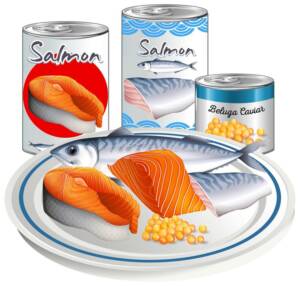
Seafood processing is one of the essential processes that aim to improve the quality and preservation of fish and seafood for long periods. With the increasing demand for these products in global markets, it has become imperative for companies to use modern technologies to ensure the provision of fresh and safe seafood to consumers.
In this article, we will discuss seafood processing comprehensively, highlighting the methods used in this field and examples of common techniques.
Seafood processing techniques
Seafood processing techniques vary according to the type of product and the required preservation period. These methods can be classified into several main methods:
1- Freezing
Freezing is one of the most widely used seafood processing techniques, as fish and seafood are frozen to preserve their freshness and nutritional value. This method is characterized by preserving seafood for long periods, and it also helps reduce the growth of bacteria and microbes that can affect the product.
2- Smoking
Smoking is a traditional method of seafood processing, where fish are exposed to smoke from burning wood or charcoal. Smoking not only gives seafood a distinctive flavor, but it also helps extend the shelf life of the product thanks to its antibacterial effect.
3- Canning
Canning is another common method of processing seafood, where fish are placed in sterile, airtight containers with the addition of preservatives. Canning helps preserve the flavor and texture and allows the product to remain fit for consumption for a long time.
4- Salting
Salting is one of the oldest methods of processing seafood. It depends on covering the fish with salt to reduce its water content and prevent the growth of bacteria. In addition, this method gives the fish a special flavor.
5- Drying
In this method, moisture is removed from the fish using heat, sun, or dry air. Drying is one of the seafood processing methods that helps preserve seafood for long periods without the need for refrigeration or freezing.
Benefits of Seafood Processing
Seafood processing contributes to many benefits for consumers and industry alike, the most important of which are:
1-Extending shelf life: Through techniques such as freezing or smoking, seafood can be preserved for longer periods without losing its quality.
2-Improving food safety: Seafood processing processes contribute to reducing health risks caused by bacteria or microbes.
3-Increasing availability: These processes allow fish and seafood to be available in markets throughout the year.
4-Improving taste and texture: Some processing techniques such as smoking and canning contribute to improving the flavor and texture of the product.
Examples of processed seafood
Here are some common examples of seafood that undergo processing processes:
1-Canned sardines: Sardines are one of the most famous examples of seafood processed by canning.
2-Smoked fish: This includes smoked salmon and other types that are processed by smoking.
3-Frozen shrimp: One of the most common products that are processed by freezing and preserved for long periods.
4-Dried fish: such as dried fish that is dried using air or sun.
Seafood processing is an essential part of the food industry around the world. It not only improves the quality of products but also ensures their safety and availability to consumers on a permanent basis. By applying modern processing methods, companies are able to meet the growing market needs, especially in light of the increasing demand for seafood products in global markets. Processes such as freezing and canning help store fish for long periods, allowing seafood to be provided in places geographically distant from fishing areas.
Frozen seafood in global markets
Frozen seafood is one of the most prominent examples of seafood processing that is very popular in international markets. This includes fish, such as tuna and salmon, in addition to shrimp and calamari. Freezing provides an effective way to preserve seafood and achieve its availability throughout the year. Freezing also helps maintain taste, nutritional value, and texture, making it a preferred choice for many consumers.
Technological developments in seafood processing
Seafood processing technologies have witnessed significant development in recent years, as innovative technologies have emerged that aim to improve the quality of products and increase their efficiency. For example, rapid freezing techniques have been developed that help reduce the negative effects on texture and taste. Methods such as canning and vacuum packaging have also become more sophisticated, allowing for increased shelf life and reducing the need for preservatives.
Sustainability in Seafood Processing
Sustainability has become one of the most prominent challenges facing the seafood processing industry today. Many companies in this field are working to develop environmentally friendly technologies to conserve natural resources and reduce the environmental impact of processing operations. For example, some companies are focusing on using seafood processing techniques that rely on renewable energy or biodegradable packaging technologies.
Sustainable Preservation Technologies
Sustainable preservation techniques are one of the most important aspects of modern seafood processing. In this context, some producers have begun to use techniques such as freezing using liquid nitrogen, which improves the quality of fish and reduces energy consumption. There are also efforts to improve canning techniques so that the packaging is more recyclable, which helps reduce environmental waste.
Processed Seafood Markets
Seafood markets continue to expand globally, with processed seafood being one of the products experiencing a significant increase in demand. The European and American markets are the largest markets for processed seafood, with demand for frozen, canned and smoked fish increasing. In contrast, many companies are looking to expand into Asian markets, where seafood consumption is also growing.
Future trends in seafood processing
The seafood processing industry is expected to continue its growth in the future, with a greater focus on the application of modern technologies that contribute to improving efficiency and maintaining quality. There are also trends towards the use of technologies that contribute to reducing the environmental impact, such as smart packaging, which helps reduce food waste, which will contribute to improving sustainability in the seafood industry
Seafood processing is one of the essential processes that contribute to ensuring the provision of a safe and high-quality food product to consumers. With the continuous development of processing technologies, this process becomes more effective and efficient. If you are looking for specialized consultations in this field, ProNano Food Consulting will be your ideal partner in achieving your success in the seafood industry
Contact ProNano Food Consulting for the best advice and guidance that will help you excel in this growing and important sector
Read more about short-term canned foods



